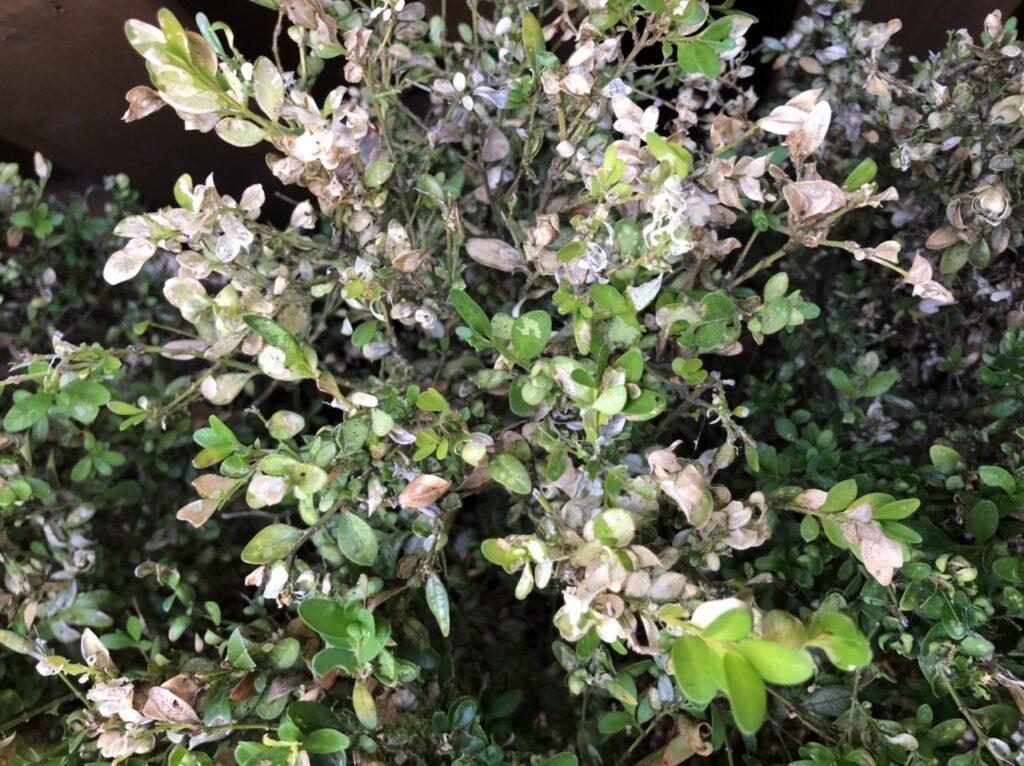
Hi
We have a Boxwood hedge that is turning brown – it seems to have suddenly worsened over the weekend. Looking at images online it looks like the leaf miner . Online resources only talk about treatment in May and early June . Any suggestions on what we can do at this stage will be greatly appreciated.
I am sorry to hear about your declining boxwoods. Boxwood Leafminer, Monarthropalpus flavus, is a common cause of leaf die back in boxwoods. The tiny orange flies, in the Gall Midge family, lay their eggs on the new growth boxwood leaf surface in spring. That is why you have read that this is an ideal time to treat infestations. When the adult flies emerge from their boxwood leaf home in the spring they are most susceptible to insecticidal soap.
Timing the application of insecticidal soap before they have deposited their eggs on new leaves is key. Gall Midge emergence, mating and egg laying occurs as soon as the weather warms up in the spring, and only lasts two to three weeks.
The use of insecticidal soap, permitted in Toronto as part of their Integrated Plant Health Program, is an effective Boxwood Leafminer control method, but only if you can time it with the emergence of the adult midges. This control method can kill beneficial insects if they come in contact with the spray. Many native birds, spiders and Green Lacewings are natural predators of the Boxwood Leafminer, so insecticidal soap should be applied with care and following the recommended application guidelines.
If you look closely at an infested leaf you should be able to see areas of the leaf surface that are raised, like a blister. Each raised lump on the leaf is an individual ‘leaf mine’ containing a maggot- the larvae of the Boxwood Leafminer, which are about 3mm long.
In spring and summer, the maggots tunnel and eat through the inside of the leaf, separating the leaf surface and underside, impeding the flow of nutrients within the leaf. As they progress, the blisters on the leaf will change colour from yellow to brown.
The sudden die back of your hedge over a few days is likely to have been caused by the combination of prolonged hot weather and the inability of the leaves to uptake water and nutrients due to advanced leaf mines.
At this stage of the summer there are still a few things that you can do to help reduce your larval count to improve the look and health of your boxwoods:
-Trim your hedge if its badly infested, or pluck off individual leaves if the affected areas are small and easily identified. Prune out any dead branches. This will remove larvae and encourage new growth.
– Support your boxwood hedges health with regular watering (once a week for established plants and more often during hot spells), nutrients and pruning away infested leaves. Boxwoods don’t like to stand in water, so ensure the soil is free draining. Add a shallow layer of good quality compost around the base of your hedge- avoiding the trunks. This will cover their shallow roots and release nutrients over time.
In early spring hang some sticky traps to attract the adult flies. Place them near your hedge, but not too close or you will be attracting the flies to your plants. This will reduce the number of egg laying adults.
If you decide to plant boxwood, Buxus, in the future choose varieties that have been cultivated for disease resistance. This includes cultivars of the English Boxwood, Buxus sempervirens and of the dwarf form- Buxus microphylla.

